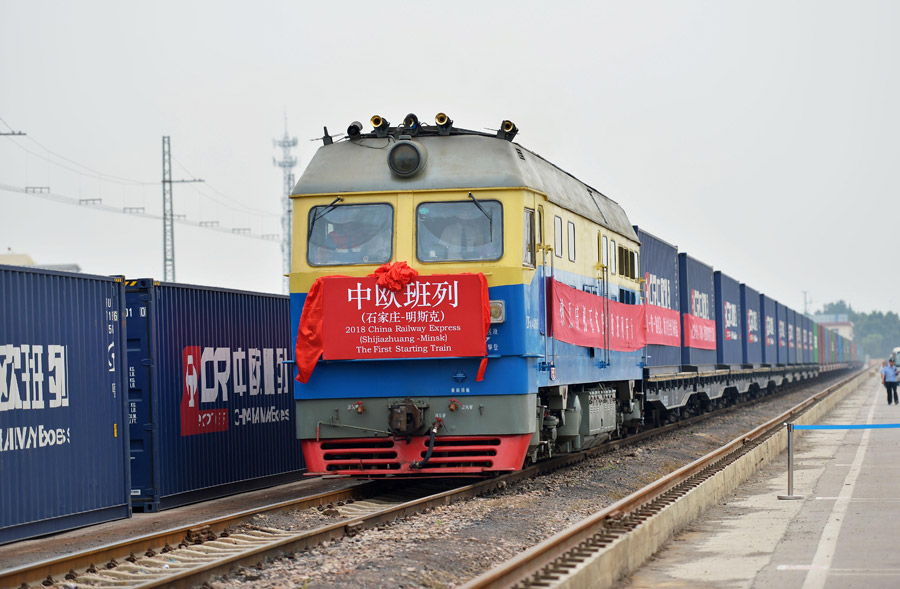Slow train to Russia plays key role in cross-border trade
Zhang Xiaojun has completed nearly 2,000 round trips between China and Russia in the past 10 years.
Zhang Xiaojun has completed nearly 2,000 round trips between China and Russia in the past 10 years, but he has never had the opportunity to travel around China's vast neighbor to the north.
On each trip, Zhang and a colleague spend about 20 hours on an international railway linking Manzhouli, in the Inner Mongolia autonomous region, and Zabaikalsk, a small city in Russia's Far East near the border, even though the railway is only 9.8 kilometers long.

Zhang Xiaojun inspects his freight train's engine before starting a round trip between China and Russia on a 9.8-kilometer railway line that connects the two countries' rail networks. [Provided To China Daily]
"It takes only 20 minutes to run on the rail one way, but it takes lots of time to go through customs and reloading because the track gauge in Russia is wider than in China," said Zhang, 50, who has been working for 28 years as a train driver at Manzhouli Railway Station.
"Then we can return while the Russian freight trains join the Trans-Siberian railway line, headed for destinations across Europe."
Zhang said that on his first day at the station, in 1990, he was told only the best drivers could join the group that operated the cross-border trains.
"It became a dream of mine to become a member of that group," he said.
However, that would not be easy for a young man who knew nothing about driving trains. To improve his skills, he seized every opportunity to learn from experienced drivers while on duty. After work, he usually chose to stay at the dormitory, studying diagrams of trains.
Whenever he encountered a train malfunction, he recorded the details in a notebook and researched it carefully in his spare time.
"It's really an effective method," he said. "The dozens of notebooks have become my treasures."
Zhang finally realized his dream of becoming a cross-border train driver in July 2008.
"I still remember how excited I was when I drove the train across the border for the first time," he said. "From the moment the train departed, I never forgot that I should pay more attention to my behavior because I was not only representing myself, but also my country."
During the long wait to go through customs and reload, Zhang and his colleague have to stay in the train's 2-square-meter cabin because they are not allowed to leave the train after it crosses the border.
"It is extremely cold in the winter, when the temperature can drop to -40 C outside, and the floor inside is usually covered by a thin layer of ice," he said.
"While in the summer, we seldom keep the air conditioner working in order to save fuel, which makes the cab quite hot."
In March 2014, Manzhouli station welcomed its first China-Europe freight train, running from Suzhou in Jiangsu province, making the largest land port on the China-Russia border even busier.
More than 1,300 freight trains ran between China and Europe via Manzhouli last year, according to China Railway Harbin Group, which operates the service.

A China-Europe freight train leaves Shijiazhuang, Hebei province, on June 2 bound for Minsk in Belarus via Manzhouli, a port in the Inner Mongolia autonomous region. [Photo/China News Service]
"Different from passenger trains, there isn't an exact time schedule for freight trains, so we're all required to be on call 24 hours a day," Zhang said.
There are 18 drivers in the cross-border team, with two assigned for each trip, he said.
"With the increase of freight volume, the departure intervals have become shorter," Zhang said, adding that sometimes he can only stay at home for 12 hours between trips.
"So in my calendar, there are no holidays, festivals or anniversaries," he said. "I feel deeply guilty that I've missed so many important family events over the years.
"Fortunately, I receive great support from my family. I hope I can devote the next 10 years to the 9.8-km railway and help transport more goods made in China to countries all over the world."